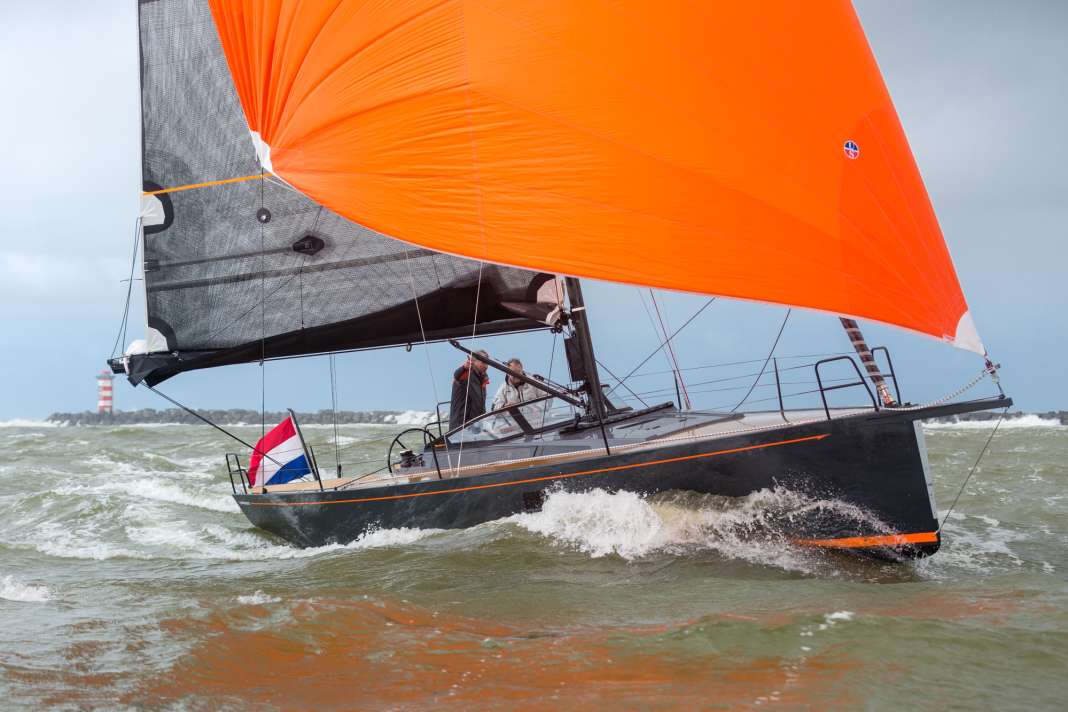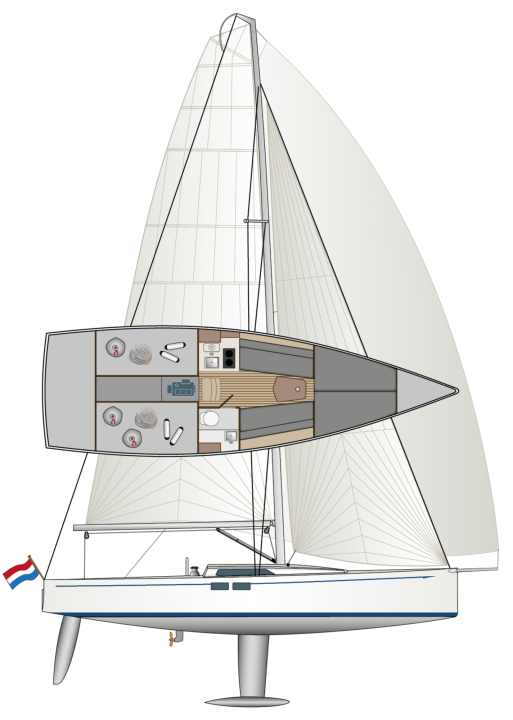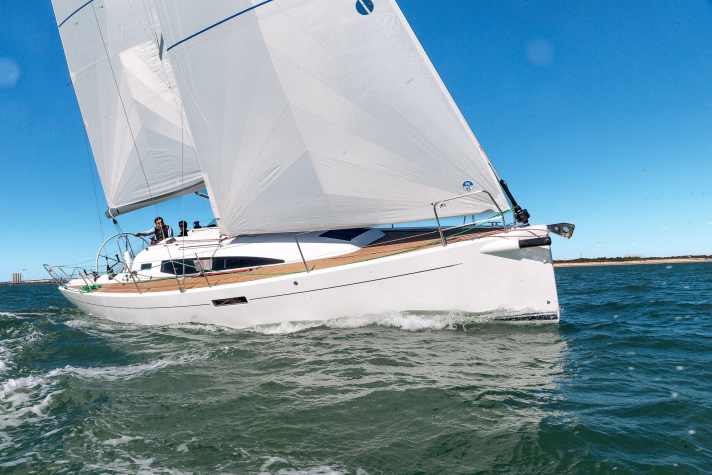





- At the centre of the action
- Full programme under sail
- Variance in the sails
- Little space to work
- Living with restrictions
- The price of the Saffier Se 37 Lounge
- Conclusion
- YACHT review of the Saffier Se 37 Lounge
- The Saffier Se 37 Lounge in detail
- The competition for the Saffier Se 37 Lounge at its market launch in 2018
The Hennevanger brothers in IJmuiden on the North Sea are known for constantly questioning the conventional and established in yacht building, and for going around it with very special and sometimes even quite unusual boats. The enterprising Dutchmen from Saffier Yachts have become successful with this strategy and have already won coveted prizes. These include the title of European Yacht of the Year - several times over.
With the Se 37 Lounge, the yacht builders in Holland have even taken a rather long diversions for another portion of extravagance, and a rather adventurous one at that. The first plan drawings and renderings were a real surprise. These revealed a completely new type of deck layout with two steering columns built far forward, almost directly against the companionway, a very compact arrangement of all lines and winches directly in front and an open guest cockpit at the back of the boat, designed as a kind of lounge area.
At the centre of the action
The market had never seen anything like this before. All the greater the general amazement, combined with the intriguing question: Can such a revolutionary arrangement even work in the cockpit of an eleven-metre yacht? And if so, why hadn't anyone come up with this idea before?
Anyone looking at the unusual cockpit layout on the Saffier Se 37 Lounge will be forced to rethink: It is a reorganisation of the conventional division of areas on sailing yachts. The helmsman and with him all the functions for setting and trimming the sails take centre stage on this boat, becoming the hub of the action on board. Meanwhile, fellow sailors enjoy the trip further aft in the spacious guest cockpit, sitting or lying down and completely undisturbed by the manoeuvring processes. Apart from the traveller, which runs across the aft deck in a recessed position, the lounge area is completely free of all functions and lines.
More from Saffier Yachts:
The strikingly wide companionway also provides a direct connection from the helm position and from the guest cockpit to the interior below deck. Direct contact and good communication between all three areas with a clear functional separation are the key factors behind this unusual concept.
Dean Hennevanger realised the ideas for the innovative cockpit design. The major challenge was not primarily the layout, but rather the resulting exceptionally long distances from the steering columns, which are mounted almost in the centre of the ship, to the rudder shaft at the rear, says the technical head of the shipyard. The declared aim: no restrictions on the usual good, very direct and sensitive steering behaviour typical of all Saffier boats. This has always been particularly important to the yacht builders in IJmuiden.
The problem could hardly have been solved with the usual cable or rope pulls, as the loss of feel would have been too great due to the sheer length and the stretch in the system. Even a hydraulic system would not have met the high demands of the Dutch for a well-functioning steering system, as the feedback from the rudder to the hand on the wheel would have been too indirect. The solution was found in a combination of chain hoists on long shaft lines below deck. The technically very complex and high-quality system proved itself in the YACHT test with an almost completely slip-free and also very direct response behaviour.
Full programme under sail
The sailing area off IJmuiden on the North Sea is well known for its unpredictability - rapid weather changes, plenty of current and sometimes huge waves often make the work of the YACHT testers an adventure here. This was also the case during the test run with the Saffier Se 37 Lounge. From a near calm to a sudden hailstorm to a gale-force gale, almost the entire potpourri of possible weather and wind conditions was experienced in quick succession.
In an initially light breeze, the new boat's very good acceleration was particularly noticeable during the test, and that only with a self-tacking jib and mainsail. With a maximum of seven knots of wind, the Dutchwoman quickly reached a speed of 5.3 knots and tacked at a very tight angle of around 80 degrees. It should be mentioned that the test boat, construction number 1, is equipped with a carbon fibre rig and higher quality sails. As standard, the boat is fitted with an aluminium mast of the same size and a set of simpler Dacron sails.
Measured values of the Saffier Se 37 Lounge




The next day the conditions were different. The wind was blowing at 25 to 30 knots and pushed an impressive wave against the Dutch coast. On the open North Sea, it was therefore impossible to think about sensible sailing and testing with the boat, which was basically designed as a daysailer. Only within the protective piers of the large industrial harbour of IJmuiden was the boat able to show what it could do in strong winds with a reef and small jib. In figures: 7.0 knots at the cross with a true wind angle of 40 degrees and a speed of just under 12 knots with the furled reacher, one of many possible additional sails along with a code zero or gennaker. Due to the very difficult conditions, these performance data are admittedly difficult to categorise. We would have liked to have sailed the Saffier Se 37 Lounge in moderate conditions at the time, which would have been more in line with its general aspirations as a sporty, luxurious daysailer.
But one thing has become clear: The boat is very agile and can be steered easily and simply on the wind edge, even with a lot of pressure and heeling. Despite the sudden gusts, loss of control or a sun shot was never an issue during the test. The Dutchwoman can be steered as if on rails, even though she only has one rudder blade. And especially on the fast courses, with a full reacher, you would be more likely to think you were sailing a thoroughbred racer than a designated day boat with a fixed cockpit disc.
Variance in the sails
As an alternative to the standard self-tacking jib, the Se 37 Lounge could also be equipped with an overlapping genoa and centreboard tracks on deck. This would mean seven square metres more sail area on the wind and a sail load factor of a sporty 5.1 instead of 4.9 with a jib. This would undoubtedly be a good choice for active sailors, perhaps even with regatta ambitions, or for inland sailing. However, in this case and for orderly manoeuvring, two additional winches on deck are essential. They would be mounted on the deck behind the helmsman.
Little space to work
In the standard arrangement, all sheets, halyards and trim lines run in channels below deck back to the two winch platforms, each with six stoppers at the side of the companionway and directly in front of the steering columns. Here, the helmsman can manoeuvre as he wishes. However, he must always strive to maintain an overview and is forced to prepare the manoeuvres well. There is very little space between the halyard stopper and the winches, and a wuhling is also quickly produced, despite the spacious halyard chutes inside the winch platforms. However, if there is no hectic rush, the processes essentially work properly. The Saffier Se 37 Lounge is also suitable for single-handed use without restriction.
The test boat was also equipped with two electric winches with a rewind function. This makes it possible to operate both winches from both windward and leeward at the touch of a button, for example the jib sheet on one side and the double-guided mainsheet on the other. This sophisticated convenience is, of course, only available as an option and at an additional cost.
Protectively laminated
Saffier Yachts builds the hulls as a GRP sandwich construction using a vacuum infusion process with polyester resins. The hull is fully laminated below the waterline. The deck is built by hand, also with a foam core. In the area of the rig standing on deck, the cabin roof is also reinforced with carbon fibre layers. The wide keel flange is located in a hull recess and the keel bolts are provided with a fine thread. This allows the shipyard to attach the appendix to the hull with greater traction. Saffier also completely overlaminates the keel bolts in the bilge after assembly to protect them against corrosion. Retightening is not necessary, say the Hennevangers. However, it could be done if necessary by simply knocking away the protective laminate.
The fresh water tank with a volume of around 120 litres is also permanently laminated in. The fixed tank is located under the bunk in the foredeck. The stainless steel fuel tank with a capacity of 65 litres is hidden underneath the cockpit floor. As an alternative to the Yanmar three-cylinder built-in diesel with an output of 30 hp, the large Saffier could also be equipped with an electric pod drive. The performance and range would probably be sufficient for use as a daysailer. You can also choose whether you want the boat with or without a fixed sea fence. Depending on this decision, the CE design category would be upgraded from C (without railing) to B (with railing).
Living with restrictions
The fact that the Saffier Se 37 Lounge is planned as a designated daysailer or weekender and without any special requirements for cruising or long trips is particularly evident below deck. The simple interior fittings only take place from the cabin bulkhead forwards. Due to the special cockpit layout with the forward-positioned steering columns and the aft cockpit galleys, a cosy interior aft is not even possible in terms of design.
Nevertheless, you can live comfortably below deck if there are two of you and you accept some restrictions in terms of comfort. For example, you can't stand below deck: the maximum height between the saloon floor and the cabin roof is just 1.47 metres, and that's only right at the companionway.
In a crouched position, you enter the generously proportioned, separate wet room with toilet, washbasin and shower option. There is also an open cupboard for oilskins. Otherwise, there is a lack of storage space below deck, which can be explained by the concept and use as a daysailer. Saffier has dispensed with side shelves and long rows of lockers in favour of a completely open, loft-like design.
The beautifully crafted, cosy upholstery, which is available in various colours and cover materials, also deserves a special mention. Two adults sleep very comfortably in the forward cabin. Two more can also sleep comfortably on the sofas by removing the back cushions.
The price of the Saffier Se 37 Lounge
Daysailers or weekenders of around eleven metres or more are rare. With the Se 37 Lounge and its extravagant cockpit design, the yacht builders at Saffier have boldly combined a number of unique selling points; there are hardly any directly comparable competitor products. This is why a market-relevant price categorisation is difficult or even impossible. The Dutch are currently asking just under 325,000 euros for the basic version of the boat.
- Base price ex shipyard: 324,300 € gross incl. 19% VAT.
- Guarantee/against osmosis: 2/2 years
As of 02/2025, how the prices shown are defined, read here!
Conclusion
The Hennevanger brothers from IJmuiden have never liked to follow the mainstream and have once again caused quite a stir with their unusual ideas. It remains to be seen whether the idea with the far-forward steering columns will catch on. The concept is certainly exciting and skilfully realised to boot.
YACHT review of the Saffier Se 37 Lounge
Its speciality is the very unconventional arrangement in the cockpit with the steering columns far forward. The idea is exciting, and it works. The price seems fairly calculated.
Design and concept
New cockpit layout
One-handed handling
Solid construction
Sailing performance and trim
Sporty sailing characteristics
Good trimming options
Little space around winches and stoppers
Living and finishing quality
Simple, beautifully built interior
Little available storage space inside
Equipment and technology
Extensive basic equipment
Self-tacking jib as standard
Highly accessible machine
The Saffier Se 37 Lounge in detail

Technical data of the Saffier 37 SE Lounge
- Design engineer: Dean Hennevanger
- CE design category: C/B
- Torso length: 11,00 m
- Width: 3,45 m
- Draught/alternative: 2,10/1,70 m
- Weight: 4,8 t
- Ballast/proportion: 2,1 t/43 %
- Mainsail: 43,0 m²
- Self-tacking jib: 25,0 m²
- machine (Yanmar): 21 kW/30 hp
Hull and deck construction
Hull: GRP sandwich with foam core, built using the vacuum infusion process. Deck: GRP hand lay-up
Shipyard
Saffier Maritiem B.V.; IJmuiden/NL; www.saffieryachts.com
Distribution
Dealer network
The competition for the Saffier Se 37 Lounge at its market launch in 2018
Brenta 38

Chic and slim daysailer from Italy. The boat and the complete rig are built from carbon fibre as standard.
Code 1 Black Pepper

High-performance retro classic, also made entirely of carbon fibre. The Code 1 is only supplied with a swivelling keel.
J/112 E

Elegant performance cruiser from France with retractable bowsprit. Can also be used as a sporty daysailer.
Tofinou 12

Attractive day boat from France with lots of wood on deck and a very cosy interior.
This test was first published in 2018 and has been revised for this online version.

